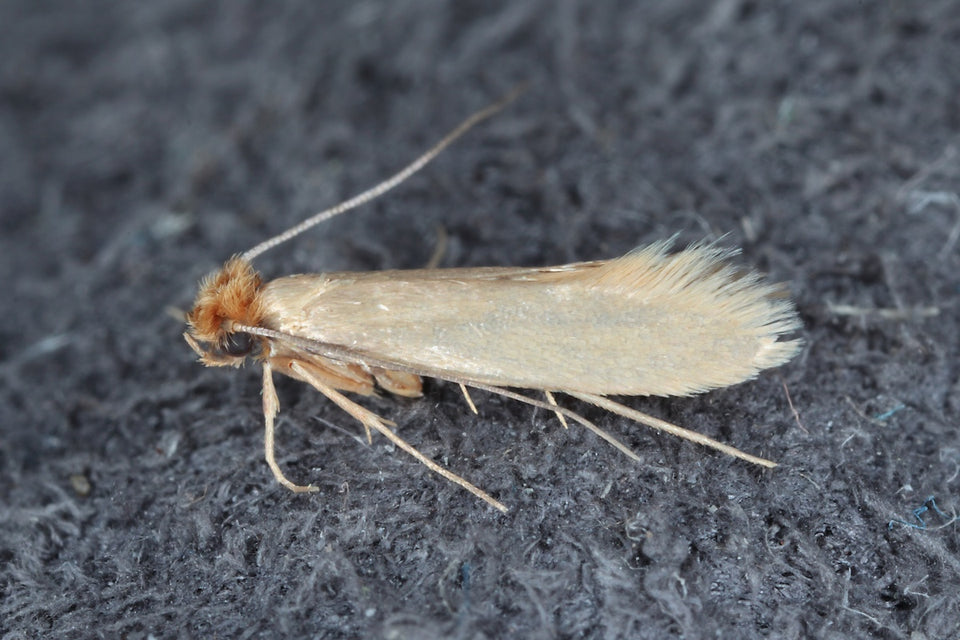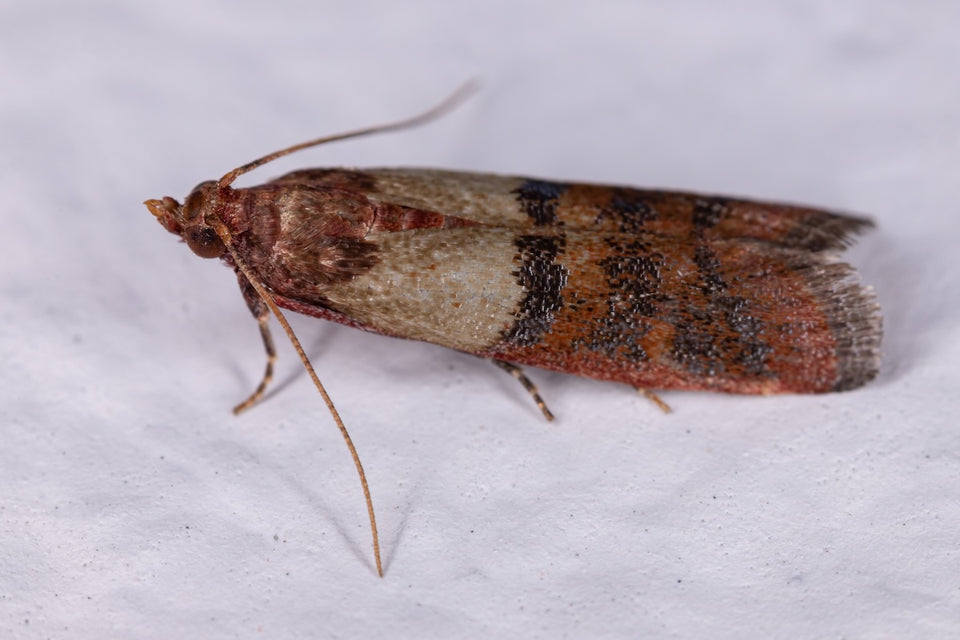Where Do Moths Go in Winter and How to Stop Them

When the weather turns cold, many people assume moths disappear until spring. After all, you rarely see them flying around at this time of year. But if you have ever found holes in sweaters, webbing in food packaging, or unexplained larvae in cupboards during winter, you know that is not the full story.
So, where do moths go in winter? The answer is that they do not go anywhere. Clothes Moths survive year-round inside UK homes, making use of dark, undisturbed spaces and the consistent warmth of central heating. To understand how to stop them, it is important to look at their life cycle and how it continues, even when you cannot see obvious signs of activity.
Why Moths Seem to Disappear When It Gets Cold
The biggest misconception is that moths die off or vanish once the temperature drops. In reality, the moth life cycle simply slows down. Adult moths live only 30 to 45 days, and in summer you notice them more because the warmth speeds up development, producing more adults at once.
In winter, adult emergence is less frequent, and those that do appear tend to stay hidden in dark corners or close to the floor. Clothes Moths are not attracted to light like other species, so it is easy to miss them. Meanwhile, the most damaging stage, the larvae, continues feeding quietly on fabrics or dry food supplies.
This means infestations often persist undetected through the colder months, only to flare up again in spring when rising temperatures accelerate the cycle. Without intervention, the problem does not go away - it simply becomes less visible.
How Clothes Moths Survive the Colder Months

Clothes Moths, especially the common Webbing Clothes Moth, lay eggs directly onto fabrics containing keratin, the protein found in animal-based fibers like wool, silk, cashmere, and fur. Eggs hatch in as little as 4 to 10 days, and the larvae that emerge begin feeding straight away.
The larval stage is the most destructive and can last from a few weeks to several months depending on warmth, humidity, and food availability. In centrally heated homes, larvae continue feeding throughout winter, damaging garments stored in wardrobes, drawers, and other undisturbed spaces.
When temperatures rise in spring, any surviving larvae pupate and emerge as adults, ready to breed again. This is how a small winter infestation can quickly escalate into a full-scale problem by the time warmer weather returns.
How Pantry Moths Survive Indoors All Year

Pantry Moths, also known as Indianmeal Moths, use the same survival strategy. Females lay eggs in or near dry food stuff such as cereals, flour, rice, nuts, or pet food. The larvae tunnel through food supplies, leaving webbing and frass (droppings) behind.
Even unopened packets are not always safe, since larvae can chew through thin cardboard or plastic. Inside heated kitchens, larvae continue feeding during winter, spreading from one item to another if food is not sealed properly.
Just as with Clothes Moths, adult activity may seem to slow down in winter, but eggs and larvae ensure the infestation carries on. When conditions warm up again, adult moths emerge in higher numbers and the problem grows more obvious.
Why Traps Still Matter When You Don’t See Moths
Because moth activity is less visible in colder months, traps become even more important. Clothes Moth Traps and Pantry Moth Traps work by attracting and catching adult males, preventing them from breeding and giving you a clear signal of whether moths are active.

Even if you do not see moths flying around, adults can still emerge inside a centrally heated home at any time. Traps provide early detection and help interrupt the breeding cycle before it gets fully underway in spring. For best protection, keep Clothes Moth Traps in wardrobes and cupboards year-round, replacing them every 12 weeks or when they are full, and keep Pantry Moth Traps in food storage areas, replacing them every 8 weeks.
Protecting Your Home Through the Colder Months
Preventing moth infestations in winter is about steady habits rather than a single deep clean.
For clothing, always wash or dry clean garments before storage. Clothes Moths are attracted to fibers with perspiration, oils, or food traces, so unwashed and soiled items are especially at risk. Store them in breathable cotton bags that allow airflow and keep moisture out, and keep wardrobes clean and free from lint, dust, or hair. Even occasional disturbance of stored items helps discourage females from laying eggs.
For food, transfer dry goods into airtight containers made from glass, metal, or sturdy plastic. Thin packaging is no barrier to Pantry Moth Larvae. Inspect new purchases before storing, freeze bulk items if you suspect contamination, and clean cupboards with a cleaning solution to remove hidden eggs.

Finally, keep monitoring with traps. Clothes Moth Traps belong in wardrobes and storage spaces, while Pantry Moth Traps should stay in cupboards year-round. Replace them regularly to detect adult males as soon as they emerge, breaking the cycle before spring activity increases.
Your Winter Moth Questions, Answered
Do moths die off in winter?
No. While outdoor populations slow in cold weather, indoor infestations continue because centrally heated homes provide warmth and protection. Eggs and larvae survive easily and can remain active in fabrics, carpets, or food packaging.
Why do I not see moths flying in winter?
Clothes Moths avoid light and prefer dark, undisturbed areas. In winter, fewer adults emerge at once, and those that do often stay hidden low to the ground or in corners. This makes them harder to notice, but it does not mean the infestation has gone.
What stage of the moth life cycle survives winter?
All stages can survive indoors. Eggs hatch within days, larvae continue feeding for weeks or months, pupae may lie dormant until conditions improve, and adults can emerge even in winter in heated homes. It is the moth larvae that causes the damage to your textiles and food.
Do I still need traps in winter if I don’t see activity?
Yes. Traps are an early warning system, catching adult males even when activity is low. They help confirm whether moths are still present and reduce the chance of breeding. Without traps, you may only realise moths are active once damage becomes visible.
Can moth larvae feed in cold conditions?
Yes, inside heated homes. Larvae do slow down in unheated, very cold areas, but in wardrobes, cupboards, and kitchens that stay warm, they continue feeding on fabrics or dry foodstuffs.
Will the infestation come back in spring?
If larvae survive the winter, they will pupate and emerge as adults in spring, restarting the cycle. Without consistent cleaning, airtight storage, and monitoring with traps, a winter infestation can quickly expand into a much larger outbreak.
What foods are most at risk in winter?
Pantry Moths target cereals, flour, rice, nuts, dried fruit, chocolate, pet food, and bird seed. These foods are commonly stockpiled during colder months, which increases the chance of unnoticed infestations spreading.
Do Clothes Moths only damage expensive clothing?
No. Clothes Moths are not only drawn to “luxury” items but any materials that contain keratin. Wool, silk, cashmere, fur, and feathers are all high in this protein, regardless of price. However, damage is often most noticeable on expensive garments made from these materials.
About MothPrevention
MothPrevention® speak to customers every day about their clothes moth issues - clothes moths are a species that are ever increasing and that can cause significant damage to clothes, carpets and other home textiles.
To date, we’ve helped over 250,000 customers deal with their moth problems. We have developed professional grade solutions including proprietary pheromones and trap design, not available from anybody else in the USA.





